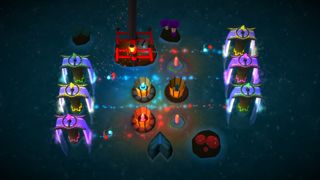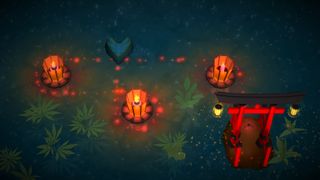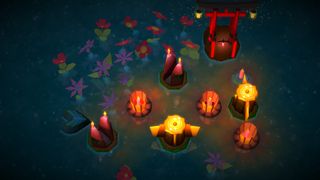Composing the score for puzzle game Ashi: Lake of Light
We talk to the game's composer David Barber about his influences, and the challenges of making music for a puzzle game.

I generally expect to get stuck in puzzle games. Getting unstuck is the point of playing, right? Ashi: Lake of Light was challenging, at least sometimes, yet I never felt unable to proceed for long, and this was surprisingly nice. The interactable game pieces have a limited number of states so, if you can’t see a solution, you can experiment to get clues, without feeling like you solved it by accident. Some pieces can’t be changed, so it’s also possible to work backwards around what must happen. If one approach isn’t working, there are other things to try.
Fireflies must be guided to arches around floating candle holders, depending on how well lit they are. One candle will prompt a quarter turn, whereas two will send the firefly back the way it came, and so on. Sometimes you’ll need to move the holders along rails to new positions and levels are further complicated by teleporters and colour, with the firefly changing between red and blue, then being attracted to candles of their new hue. There were enough incrementally added game pieces to keep my interest without being overwhelming.
I was also pleasantly surprised by how engaging the soundtrack is. Generally, I prefer sparse music in puzzle games, but only because I’m trying to concentrate on getting unstuck. Given the carefree nature of play, it’s like taking the game to a concert, rather than hearing game music incidentally. I reached out to composer, David Barber, to ask after his intention for the music. He replied with a detailed interview that delves into many aspects of his process.
PCG: How did you decide on an instrumental palette that combines traditional, orchestral and electronic instruments?
David Barber: With such strong use of Japanese imagery throughout the game an obvious choice were traditional Japanese instruments like koto, shakuhachi, and shamisen. Each had their role to play, the sound of the koto perfectly represents the ebb and flow of water; the shakuhachi is mystical and plaintive; the shamisen is playful and curious.
I felt traditional orchestral instruments like strings would add a sense of gravitas and adventure whilst woodwinds, like flute, perfectly capture the movements of a darting firefly. The use of orchestra generally evokes that cinematic, larger than life, feeling that we, as audiences, are so used to hearing in film.
The use of solo instruments like violin, cello, and woodwinds is, I feel, a great way to capture the feel of a solitary figure on a journey. A great example of this is Austin Wintory’s score for Journey.
The biggest gaming news, reviews and hardware deals
Keep up to date with the most important stories and the best deals, as picked by the PC Gamer team.
I love music which blends subtle, organic electronics with traditional instruments, like Gareth Coker’s score for Ori and the Blind Forest. Electronics do a great job of creating a sort of meditative atmosphere as well as keeping things bubbling along under the surface.
PCG: How did you create melodies and develop melodic motifs?
DB: I’m a huge fan of composers like Debussy and Takemitsu with their use of pointillistic textures as well as using the timbre of particular instruments to represent different elements of nature. I felt that sort of approach would be perfect for creating the ambient, dream-like vibe we were aiming for with Ashi.
The use of traditional Japanese pentatonic scales or modes like the Hirajōshi and In scale were great for creating washes of colour - often with koto, mallet percussion and piano - and don’t always bind you to a major or minor tonality the way that western music often can.

Using creative layering we were able to also incorporate more prominent melodic ideas that didn’t become tiresome when looped. A lot of the time these motifs were based on very short melodic fragments of 4-5 notes, but were then transformed in a number of ways, placed in a different underlying harmonic context, or passed around amongst different instruments. As a composer, I think there is great value in seeing how far you can develop one simple idea, rather than always using every tool in the shed.
PCG: What kind of mood did you aim to hit?
DB: Very early on, Nick and I spoke not only about the overall mood of the soundtrack but also how it would evolve with each track. The main goal was to create a sense of calm and tranquility and in doing so help the player achieve a Zen-like state. We also wanted the music to evoke a feeling of curiosity and adventure. After all, it has to be fun!
Nick and I both agreed that although Ashi is a gentle, relaxing puzzle game, it should also feel cinematic in scope.
PCG: How was this achieved, musically?
DB: In a similar way to The Planets by Gustav Holst, I tried to imbue each track with it’s own personality, each complementing a different facet of gameplay or the overall experience. The use of modes of both traditional Japanese scales and Western scales is a great way of achieving this as each one has their own flavour. There is a track that favours the Dorian mode and feels hopeful, but also slightly mysterious; a track that utilises the Hirajōshi scale (and its modes) and feels other-worldly and floating; another that a uses a mode of the In scale and feels playful and curious.
Harmonically, I rarely think of chord progressions too methodically or theoretically, but more about tension and release; how much tension, where should it climax, should it be meandering or heading toward a goal. I composed each track like it’s own mini-journey with peaks and troughs, sometimes using key changes, other times using orchestration to go from big to small. Often I would use a base drone layer to bring a feeling of stability and other times use more rhythmical active figures to bring a sense of movement and energy.

The way each track is mixed can also have a huge emotional impact. Sometimes the music can feel up-close and intimate with a solo violin or flute, other times - with use of reverb - distant and haunting.
PCG: How did you hope music would support the player's experience of the game?
DB: The aim was firstly to create a feeling of serenity and have the player so immersed in the game that they could block out the outside world for just a little while. First and foremost it’s about supporting the gameplay, graphics and sound effects to create an enticing atmosphere for the player, then if they come away with a tune stuck in their head that’s an added bonus!
We also felt that the player should feel like they are on a journey and the development of the music should somehow reward them the further they progress. We didn’t want the music to feel tired or repetitive as we want the player to come back to a slightly different experience each time they play, even if they decide to go back and replay previously completed levels.
PCG: How did you approach creating music that loops?
DB: Knowing that players could be spending anywhere from a few minutes to a few hours playing Ashi, we had to implement the music in a way that would allow the it to be familiar but not repetitive. We also wanted the soundtrack to feel like one continuously evolving track rather than several short looping tracks. To achieve this, Nick incorporated a custom audio engine into the game - rather than using audio middleware like Fmod or Wwise. I would deliver each 2-3 minute audio track split into multiple synced stereo layers or ‘stems’ - like strings, winds and bells, drones etc. The audio engine plays and loops all layers simultaneously but begins with only one layer at full volume. Each layer is dynamically faded up to full volume based on a player’s progress until eventually all layers are present and playing back in sync. The goal is for each track to loop several times without the player being aware of it. When composing, the challenge is composing each track in a way that would allow different combinations of layers, single layers, or all layers to function as a complete track in themselves.
To seamlessly move between different tracks I also created a number of short ‘transition’ tracks which would be triggered at certain points throughout the game so that there was no abrupt end to a track or a really obvious crossfade.
You can learn more about the Ashi: Lake of Light here.
Most Popular

